Introduction
Ever since 1995, I have used a particular type of wheatgrass extract to accelerate the healing of a broad spectrum of medical conditions and injuries - often when standard treatments had failed, (view examples), - that is completely devoid of adverse side effects.
Impossible? Not really - because the extract, containing at least 20 ligands, appears to rapidly reconnect dysfunctional peripheral cellular receptors to the brain - which then responds accordingly - often instantaneously.
Wounds also heal much faster, and pain is eliminated or reduced, often after standard medical treatments have failed. For example, venous leg ulcers, second-degree burns, and leprosy ulcers.
In Figure 1, the extract has almost instantaneously relieved the patient's pain from a minor second-degree burn, and has hastened its healing. Also, the blister, which hasn't burst, helps prevent wound infection. Comparison of the minor burn with the severe radiation burns shown in Figure 2, shows both injuries have clearly healed rapidly, and were reported pain-free.
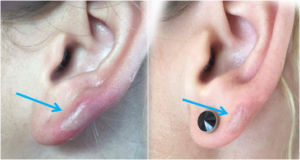
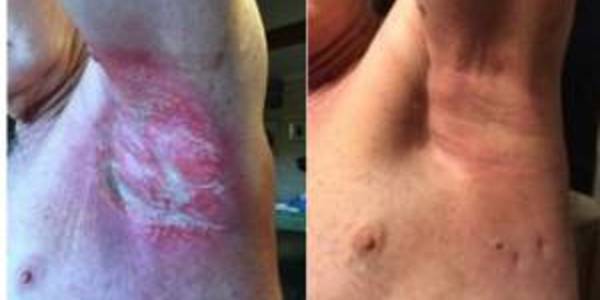
A small selection of wheatgrass extract's remarkable ability to heal:
How does wheatgrass extract work?
It appears that 20 ligands known to exist in the extract, are capable of assisting re-connection of dysfunctional cellular receptors to the brain (e.g. in Fig. 2.) Also, in the short list following of "Recovered" conditions, remarkable recoveries of ten separate physical injuries can be seen.
How wheatgrass extract appears to accelerate healing
The blood-brain barrier (BBB) prevents most drugs (other than very small molecules) from directly influencing the brain. However, ligands present in wheatgrass extract appear to reactivate dysfunctional cellular receptors, which enables them to reconnect directly to the brain.
Ligands are molecules that activate cellular-receptor DNA to release neurotransmitters that send sensory messages such as pain, pressure, taste, vision, touch etc., to the brain. For instance, in Figure 3, "dysfunctional" connections to the brain from skin, lungs, intestines, liver, heart etc. could lead to broad dysfunctions of many, or possibly all body organs. But, by simply applying ligand-rich wheatgrass extract over disaffected skin area(s), or by taking the extract orally, many of these dysfunctional areas can be rapidly restored as demonstrated by numerous clinical observations since 1995.

But how does wheatgrass extract ease pain and heal many medical conditions and injuries?
We know that cell receptors signal pain from a pin prick in the skin to the brain via the neurotransmitter, Substance P, making the "victim" instantly withdraw his/her hand. However, if wheatgrass extract is then applied to the painful area, pain eases quickly because of the negative influence of Substance P preventing it from reaching the brain.
Also, many "infertile" women have conceived after taking a daily small dose of wheatgrass extract, apparently by 'normalisation' of the hypothalamic-pituitary-adrenal axis. (HPA).
More examples of wheatgrass extract healing
Effective healing of leprosy ulcers has defied "modern medicine" for centuries, but wheatgrass extract, if applied regularly to the affected area(s) can eliminate the infection. For instance, numerous attempts had been made to heal this patient's leprous ulcer, for 8 years, but failed. (Fig. 4.) However, after wheatgrass extract was applied regularly to the area, the wound healed in five months. (View more cases.)
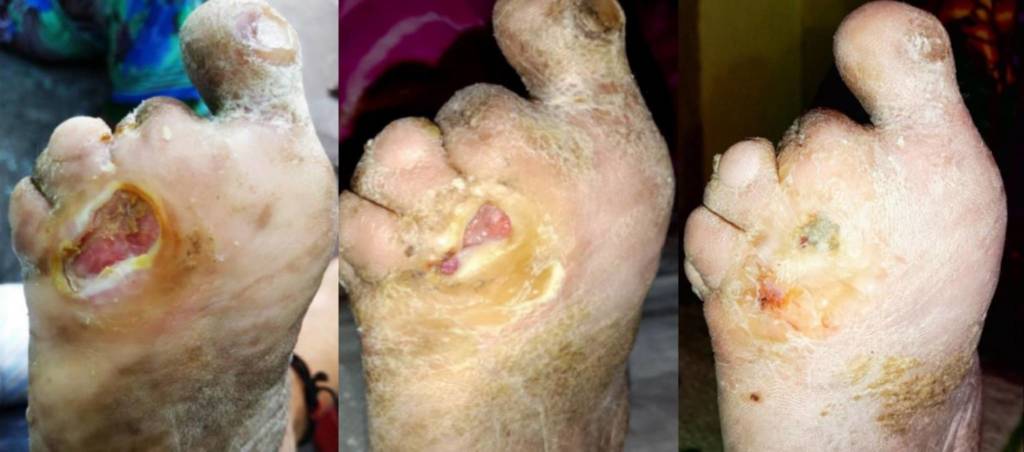
Also, in this psoriatic case (Fig. 6.), we see a different response to the wheatgrass extract.
The patient's lesions have resisted many types of skin treatments, including 15 years of topical steroids that have severely thinned and damaged the skin's protective properties, and also it's ability to re-connect to the brain. However, after 2 months' treatment (twice monthly) with the wheatgrass extract, the lesions have darkened significantly, and enlarged. This is not because the patient's skin has worsened, but the wheatgrass extract has "re-activated" cellular receptors around the affected areas, "notifying" the brain (via cellular receptors) that blood supply to the area is required - and it has responded. Also, the darkened, enlarged spots on the right are likely the result of restoration of normal blood supply to the affected areas, suggesting that the brain is working to eliminate the "lesions. Had treatment continued, the lesions would likely have disappeared in due course.
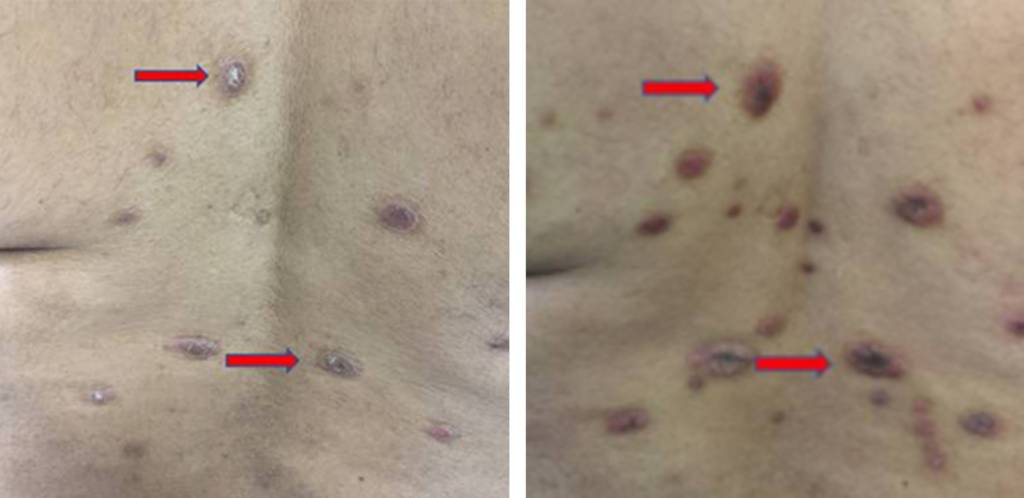
Another example of wheatgrass extract's remarkable therapeutic ability is the healing of topical steroid damaged skin, by reconnecting dysfunctional cellular receptors, destroyed or damaged by topical steroids, to the brain. It may take several months to restore the damage, but perseverance works - just by applying the extract twice weekly - and persevering.
Also, the young woman in Figure 7 had suffered from psoriasis for three years as topical steroids severely aggravated her condition. (Some of these drugs can do severe damage to the skin by destroying cellular receptors in the area.) However, once weekly application of wheatgrass extract completely restored her skin in four months. Compared with the patient in Figure 6, the remarkable response of this teenage girl's skin to wheatgrass extract is remarkable.
Most, if not all drug treatments for psoriasis (and eczema) such as topical steroids should be avoided. Although they may temporarily reduce inflammation to some extent, they do nothing to restore the damaged skin and its numerous essential protective functions. In fact they do more damage and expose the patient to infection.
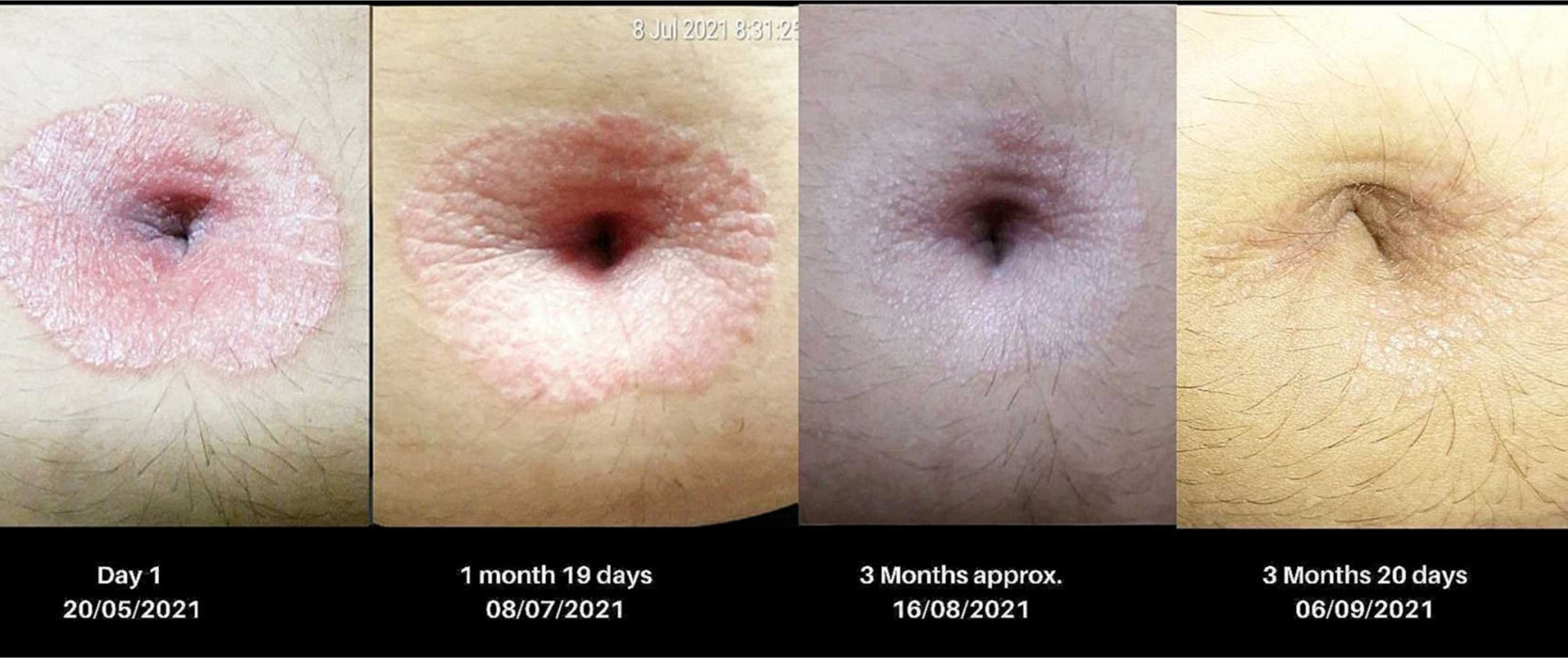
In this last case of serious psoriasis, wheatgrass extract eliminates skin plaques and restores the patient's skin to almost normal, in just 2 weeks
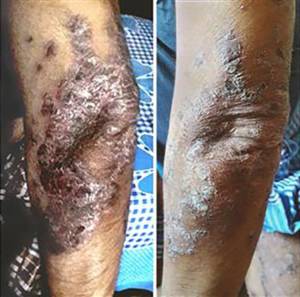
Just two weeks after wheatgrass extract was applied to the affected area, (Fig. 13.) there has been remarkable recovery of the patient's skin after two applications. The large areas of thick plaque have almost disappeared, revealing normal skin underneath. This suggests there has been a rapid "re-connection" (re-coupling) between the psoriatically damaged skin area and the brain which has then responded to help restore the patient's skin to normal. Also, in this case, the patient is young, which could also help expedite the healing process.
This case also suggests that psoriasis may develop due to dysfunctional cellular receptors evolving near the skin's surface. This concept may also lead to other conditions such as skin disorders, hemorrhage, pain, itchiness etc. that all often respond well to wheatgrass extract.
Dr. Chris Reynolds.
Australia.
